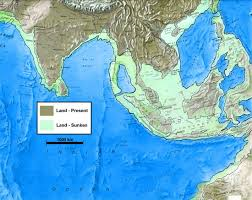Sundaland
 Sundaland is the name of a large biogeographical region of South East Asia, a large portion of which had been above sea level during the last Ice Age and later inundated as the glaciers retreated. The term was apparently first used[1629] in 1949 by R.W. van Bemmelen (1868-1941) and later by other authorities.
Sundaland is the name of a large biogeographical region of South East Asia, a large portion of which had been above sea level during the last Ice Age and later inundated as the glaciers retreated. The term was apparently first used[1629] in 1949 by R.W. van Bemmelen (1868-1941) and later by other authorities.
It is worth noting that it is now generally accepted that South East Asia was probably the entry point of modern humans from Africa. Human traces have been found in Papua New Guinea that have been dated to around 40,000 BC.
Some authors have specifically claimed a clear link between Sundaland and Plato’s Atlantis. The Sunda Sub-Oceanic Plain is large enough to match Plato’s description of Atlantis. Its topography, climate, flora and fauna together with aspects of local mythologies, all permit a convincing case to be made to support this idea.
C.W. Leadbeater (1854-1934) who was a prominent theosophist was perhaps the first to suggest a link between Atlantis and Indonesia in his book, The Occult History of Java [1094], which is now available online(f).
Other investigators have written on the prehistory of the region of whom the best known is probably Stephen Oppenheimer who firmly locates the Garden of Eden in this region[004], although he makes little reference to Atlantis. More recently, Robert Schoch, in collaboration with Robert Aquinas McNally, wrote a book[455] in which they suggest that pyramid building may have had its origins in a civilisation that flourished on parts of Sundaland that are now submerged.
The first book to specifically identify Sundaland with Atlantis was written by Zia Abbas[001]. However, prior to its publication, the Internet offered at least two sites that discussed in detail the case for Atlantis in South East Asia. William Lauritzen(a) and the late Professor Arysio Nunes dos Santos(b) developed extensive websites. Lauritzen has also written an e-book that is available from his site, while Santos developed his views on an Asian Atlantis in another recent book[320]. Dr Sunil Prasannan has an interesting essay on Graham Hancock’s website(c). A more esoteric site(d) also offers support for the Sundaland theory.
An Indonesian researcher, Panji R. Hadinoto, has published on his website(e) a 32 point checklist purporting to ‘prove’ that Atlantis was located on Sundaland. Unfortunately, this checklist is not original but copied from the work of Professor dos Santos.
April 2015 saw further support for an Indonesian Atlantis with the publication of a book[1093] by a hydraulic engineer, Dhani Irwanto, who endeavours to identify features of the lost city with details in Plato’s account with a site in the Java Sea off the coast of the island of Kilmantan. He has now published a YouTube video in support of his theory(h).
In 2019, Irwanto published two new books, the first, Sundaland: Tracing the Cradle of Civilisations [1618], in which he offers a compelling case for considering emigrants from a submerging Sundaland as bringers of embryonic civilisation to other lands, where it flourished and developed local variants. It crossed my mind that Irwanto’s contention might explain the origins of the likes of the Sumerian civilisation, among others, which have never been satisfactorily settled!
The second book, Land of Punt [1628], is another interesting offering in which the author suggests that Punt and the biblical Ophir can be equated with Atlantis, located in Sundaland. However, this idea conflicts with a growing consensus(k) that places Punt in the region of the Horn of Africa or across the Red Sea in Arabia.
A 2016 series of graphics shows the gradual inundation of Sundaland from 18,000 BC onwards(g).
Thorwald C. Franke has drawn attention(j) to a recent controversy in Malaya where historian Zaharah Sulaiman has claimed that the Malay set of mtDNA is 63,000 years old, dating back to a time long before the submergence of Sundaland. It seems that Sulaiman had built her claim on some of Oppenheimer’s writings. This veiled suggestion of some sort of racial superiority, through antiquity, was disputed locally.(i)
Ahmad Yanuana Samantho published Atlantis Nusantara [1869] in 2015, which purports to build on the work of Arysio dos Santos with additional data that the author (or publisher) describes as ‘spectacular’. Unfortunately, the 538-page book is only available in Indonesian. Nusantara is generally used to describe the Indonesian archipelago.
(a) Welcome to Earth360.com (archive.org)
(c) https://www.grahamhancock.com/underworld/DrSunilAtlantis.php
(d) See: https://web.archive.org/web/20060508140324/https://www.tylwythteg.com/atlantis/southchina.html
(e) https://jakarta45.wordpress.com/2009/10/26/pengkajian-benua-atlantis-tempo-doeloe-di-nusantara/
(f) https://theosophists.org/library/books/occult-history-of-java/
(g) https://www.nature.com/articles/s42003-023-04510-0
(h) https://www.youtube.com/watch?v=JT23A12-tDc&feature=youtu.be
(i) Arguing against Malays’ ‘Sundaland origins’ | Opinion | Malay Mail (archive.org)
(j) Atlantis Newsletter Archive – Atlantis-Scout (atlantis-scout.de) (No.120)
(k) The Arabian Horizon – The Lost Lands: Punt | MalagaBay (archive.org)
